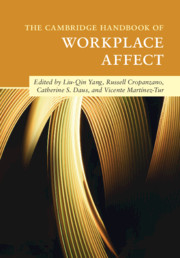Book contents
- The Cambridge Handbook of Workplace Affect
- The Cambridge Handbook of Workplace Affect
- Copyright page
- Contents
- Figures
- Tables
- Contributors
- Foreword
- Part I Theoretical and Methodological Foundations
- 1 Emotion at Work
- 2 The Organizational Neuroscience of Emotions
- 3 Personality Affect Construal Theory
- 4 Workplace Emotions and Motivation
- 5 Behavioral Genetics and Affect at Work
- 6 A Review of Quantitative Methods to Measure Workplace Affect
- 7 Qualitative Methods to Study Workplace Affect
- Part II Workplace Affect and Individual Worker Outcomes
- Part III Workplace Affect and Interpersonal and Team-Level Processes
- Part IV Workplace Affect and Organizational, Social, and Cultural Processes
- Part V Discrete Emotions at Work
- Part VI New Perspectives on Workplace Affect
- Index
- References
4 - Workplace Emotions and Motivation
Toward a Unified Approach
from Part I - Theoretical and Methodological Foundations
Published online by Cambridge University Press: 25 June 2020
- The Cambridge Handbook of Workplace Affect
- The Cambridge Handbook of Workplace Affect
- Copyright page
- Contents
- Figures
- Tables
- Contributors
- Foreword
- Part I Theoretical and Methodological Foundations
- 1 Emotion at Work
- 2 The Organizational Neuroscience of Emotions
- 3 Personality Affect Construal Theory
- 4 Workplace Emotions and Motivation
- 5 Behavioral Genetics and Affect at Work
- 6 A Review of Quantitative Methods to Measure Workplace Affect
- 7 Qualitative Methods to Study Workplace Affect
- Part II Workplace Affect and Individual Worker Outcomes
- Part III Workplace Affect and Interpersonal and Team-Level Processes
- Part IV Workplace Affect and Organizational, Social, and Cultural Processes
- Part V Discrete Emotions at Work
- Part VI New Perspectives on Workplace Affect
- Index
- References
Summary
Affect and emotions play a key role in motivational processes, working together to make sense of one’s experience and to guide behavior. Until recently, however, research on motivation in the workplace has advanced largely independently from research exploring the role of emotions and affect at work. To better understand the human experience of work, we must explore the connections between these aspects as they influence thoughts, feelings, and behaviors related to work. In this chapter we describe theory and research that supports the ultimate development of a unified perspective; namely, an approach that takes into account how emotional experiences affect and interact with motivational forces to influence work behavior and its outcomes.
- Type
- Chapter
- Information
- The Cambridge Handbook of Workplace Affect , pp. 52 - 63Publisher: Cambridge University PressPrint publication year: 2020



